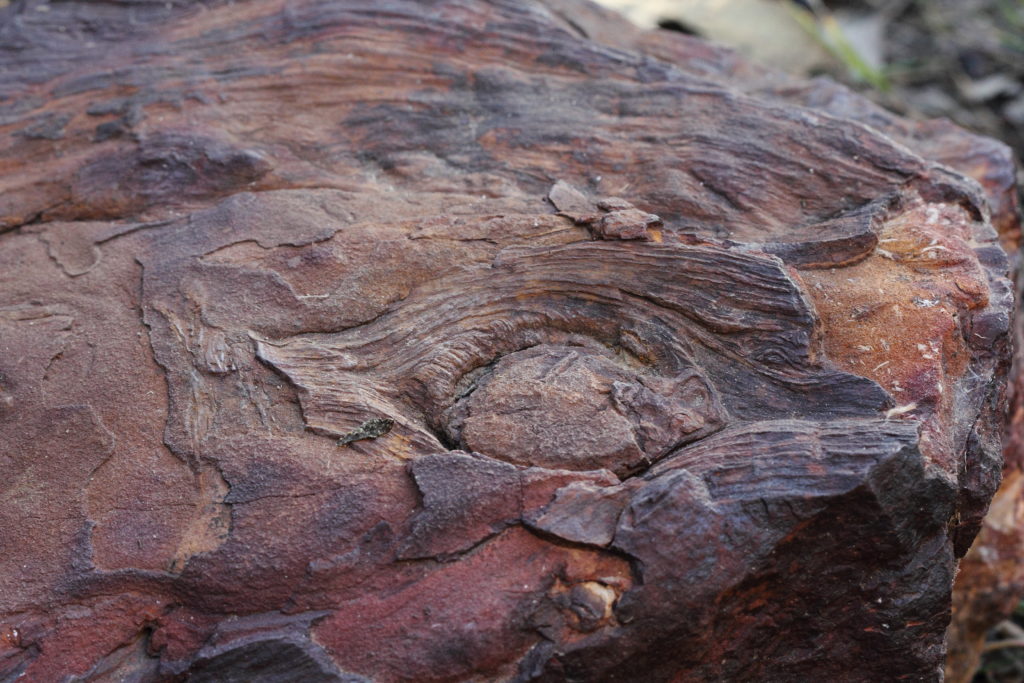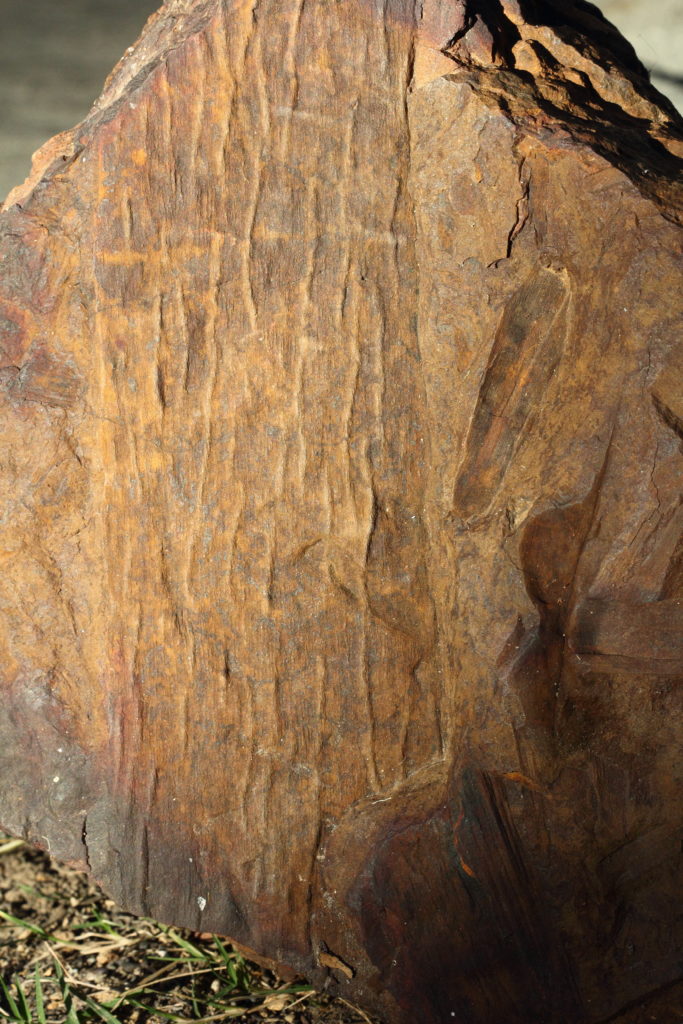Fossilised imprint of a round leaf with lots of fine veins, possibly from a ginko-type plant. All photos taken from fossils found in early Jurassic Ripley Road Sandstone on a Land for Wildlife property, Bellbird Park, Ipswich. Photos by Deborah Metters and Keith McCosh.
The rocks we see today both sustain us and show us a glimpse into the past. Old rocks tell a story of life on Earth. South East Queensland (SEQ) is relatively young, about 300 million years old, in comparison to the rest of Australia. For example, some rocks in the Pilbara, Western Australia, are a staggering 3.5 billion years old – some of the oldest rocks found on Earth – and the Earth is about 4.6 billion years old.
Stories are found in the fossils left in the rocks. Fossils can only be found in sedimentary rocks. These rocks are products of erosion that form layers at the bottom of a lake or ocean, and gradually cement together to form rock. These fossils form markers in the various rock layers and help tell stories of life on Earth and the movement of continents. Of course, no one place has the whole story, so little pieces must be collected from all over the world. SEQ has some from the Triassic, Jurassic and the Cenozoic. The rest of Queensland has a lot more from different ages.
Fossils can be made up of actual remains (bones, teeth, hard bits, etc), impressions, and traces (such as tracks, burrows and even scats (yes – fossilised poo)). Bones can be preserved in rocks as original material or in an altered form, where silica replaces the original material, molecule by molecule, called ‘silicification’. Petrified wood is actually ‘silicified’ wood. Sometimes this silica can produce beautiful colours when it forms ‘opal’, under special conditions.
In SEQ, the Triassic Period (~252-201 million years ago – MYA) was the most important. The Triassic created most of the sandstones that underlie much of SEQ. The Clarence Moreton Basin (Roma-IpswichGrafton) was a vast swampy valley with thick vegetation and early dinosaurs. Lots of coal formed as the basin began to fill up, especially around Ipswich. Some volcanic activity created the Brisbane Tuff that now forms the Kangaroo Point cliffs.
Triassic fauna included early dinosaurs (theropods), early crocodiles (thecodonts), early amphibians (temnospondyls), early mammal-like creatures (dicynodonts), lungfish, and rather familiar-looking insects. Triassic flora included the first appearance of conifers (Araucariaceae), seed ferns (dicroidium), ginkoes, horsetails (equisetales) and ferns.
After the Triassic came the Jurassic, the ‘Age of Dinosaurs’. The Clarence Moreton Basin finally filled up with plenty of plant fossils and petrified wood. There are a few animal fossils but sadly no signs of dinosaurs, although a sauropod was found near Injune in Walloon Coal Measures. There were certainly dinosaurs here in SEQ, but so far, none have been found that died and fell into the right sort of mud, to create fossils. A small basin around Sandgate has revealed fossils from the Jurassic period.
Jurassic fauna included dinosaurs – sauropods, theropods, and ornithipods, freshwater plesiosaurs, amphibians, and fish. Jurassic flora was dominated by conifers as well as cycads, horsetails, seed ferns and ferns (including tree ferns).


The Jurassic ended about 145 MYA without much fanfare in Gondwana, except for the start of a series of inland seas across western Queensland. This was the Cretaceous Period (144-66 MYA), a monumental time for the evolution of flowering plants and the shameless manipulation of insects for the purpose of pollination. Plants used insects for cross-pollination between different individuals to keep the gene pool fit and healthy and capable of change under changing conditions. A small basin around Maryborough collected coal and fossils around this time.
The Gondwana supercontinent progressively got smaller as India and Africa left. Eventually South America and Australia left, leaving Antarctica all alone and stuck at the South Pole. The Cretaceous ended 66 MYA with a rather large bang – the Chixulub Meteor impact near the Yucatan Peninsula in Mexico, which caused the extinction of 65% of all life on Earth. The dinosaurs went extinct and a whole new world began – the Cenozoic Era or the ‘Age of Mammals’.
During the Cenozoic Era, Australia started its steady march northwards into the tropics. We got hotter and drier and developed our own peculiar fauna and flora. A few small basins in SEQ (Redbank Plains, Geebung, Beaudesert and Murgon) collected a range of ‘modern’ fossil species. Limestone areas from other parts of Queensland (Riversleigh and Mt Etna) have revealed a great array of fossil species collected around this time, about 20 MYA, and it is definitely worth visiting these sites if you are interested in fossils or geological history. A trip to Winton and Richmond is a must for fossil lovers too with a few big dinosaurs being uncovered in these areas.
Back in SEQ, you may wish to find some sedimentary rock and start digging – carefully. Or perhaps just contemplate the vast amount of time (along with the magical evolution of life) that has been used to create your little patch on Earth. A great reference is the Queensland Museum book, In Search of Ancient Queensland (reviewed on facing page).
Article by Keith McCosh
Land for Wildlife Officer
Scenic Rim Regional Council

Hi. I was looking for sites for Petrified wood as I have been digging my garden up & nearly every shovel has a piece of petrified wood in it. Some are bigger then others and really heavy. I was wondering if there is interest in them as I’m about to cover it the area with a deck. Just wondered. I live in Nambour. Cheers. Sasha.
Hi Sasha
Just wondering what part of Nambour you found the petrified wood ?
Hi Liss,
I found the petrified wood in the Panorama Drive area.
Cheers
Sasha Fenger
Following the flooding in Brisbane in March 2022, I stumbled across a small piece of petrified wood in Downfall Creek at Chermside. The floods deposited a large bank of river gravels in the creek and as I was wandering over it I noticed the piece. I wouldn’t have expected there to be petrified wood in the Downfall Creek catchment but would be interested to know if it could have come from somewhere in the catchment or whether it’s likely to have originated from somewhere else.
Hi John. Interesting. We suggest taking it to the Queensland Museum, or taking photos of it and sending them through to the Qld Museum Ask an Expert page https://www.qm.qld.gov.au/Explore/Find+out+about/Ask+an+Expert/Ask+a+Question
Hi Deborah, thanks for the tip. The Museum replied with the following:
We can’t say for certain where the piece of fossil wood came from, but it’s certainly possible that it’s from the local area. Downfall Creek cuts through a rock unit called the Ipswich Coal Measures. These rocks date to the Late Triassic period, about 230 million years ago. Fossil wood from these rocks is thought to be mostly from conifers (something a bit like a modern Bunya or Kauri Pine).
“… but sadly no signs of [Jurassic-aged] dinosaurs [in the SEQ Clarence Moreton Basin]”. Dinosaur footprint fossils are known from underground mines sites from Rosewood (at least 10 different sites) and Oakey (one site). These are predominately theropod in origin. The sauropod bone fossils you refer to, are of Rhoetosaurus and come from the stratigraphic group called ‘Injune Creek’ of the Walloon Coal Measures. The fossil site is in the Durham Downs